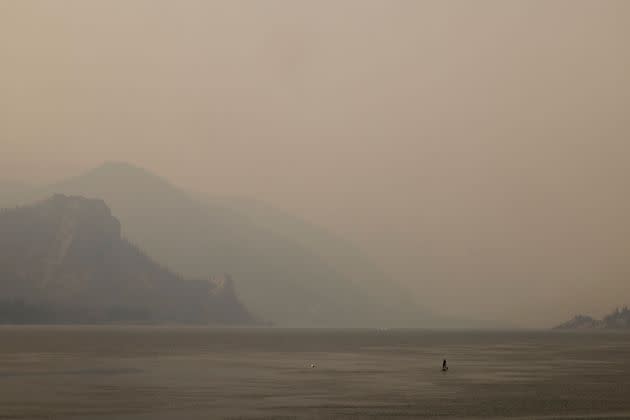This Year's Record-Breaking Climate Disasters Usher In A Horrific New Normal
This year’s devastating climate disasters, while breaking records, are only a glimpse at the worsening heat, fires, storms and floods expected in years to come.
Over the past year, we’ve seen the hottest July ever recorded on the planet (again), the largest ever single wildfire in California history (again), and deadly hurricanes and flooding along the Gulf of Mexico and the Atlantic coasts (again).
This year’s United Nations climate report repeated what similar reports have been saying for years, with even greater certainty: Humans are the “unequivocal” cause of climate change, and the window to avoid catastrophic living conditions worldwide due to global warming is rapidly closing.
“We’re looking at a long-term, undeniable trend,” said Astrid Caldas, a senior climate scientist at the Union of Concerned Scientists. She noted that the last seven years have been the hottest on record, adding, “Imagine what we’re in for if warming continues unabated.”
“Climate change is here now, and we need to act now to keep it in check.”
Climate experts have repeated calls to governments and corporations to reduce fossil fuel emissions to stave off the worst of the climate crisis’s effects.
The communities most vulnerable to climate change — including those going through slower recoveries after disasters — are disproportionately poor, Black and Latinx.
Here are some of this year’s historic climate disasters — which we can expect more of in the future.

Extreme Heat
In July, Earth’s hottest month ever recorded, temperatures soared above 100 degrees in California and the Pacific Northwest, causing hundreds to die from heat-related causes, with some of the victims being undocumented farmworkers.
“2021 once again highlights the narrative that it is no longer a ‘new normal’ but normal,” said Marshall Shepherd, director of the University of Georgia’s atmospheric sciences program. “The bigger concern now is the next phase — continued acceleration of the pace of such extremes.”
A report by the Adrienne-Arsht Rockefeller Foundation Resilience Center forecast that extreme heat could kill tens of thousands of Americans each year in the coming decades unless significant action is taken to combat the climate crisis. Nearly all U.S. counties will be affected by extreme heat in the coming years, disproportionately harming Black and Latinx people.
The climate of the 20th Century — which society’s infrastructure was designed for — no longer exists.Jeff Masters, meteorologist for Yale Climate Connections

Record Wildfires
In California — which is under a drought emergency after recording its driest year in nearly a century — wildfires have continued to worsen. This July, the Dixie fire in Northern California grew to the largest single fire in state history. Eight of the 10 largest fires in California history took place in just the last five years.
Only two fires in California history have ever crossed the Sierra Nevada — and both took place this year, just a month apart.
“There is fire activity in California that we have never seen before,” Thom Porter, chief of the California Department of Forestry and Fire Protection, said in August as the Caldor fire near Lake Tahoe showed an “unprecedented” spread of more than 20,000 acres in one day. “Every acre can and will burn in this state,” the Cal Fire chief warned.

Devastating Storms And Floods
This year was the third most active Atlantic hurricane season on record, according to the National Oceanic and Atmospheric Administration. It was the first time that two hurricane seasons in a row had so many storms that the agency ran beyond its list of 21 storm names.
Hurricane Ida slammed into the Louisiana coast in September as a Category 4 storm, making it one of the strongest ever to make landfall in the state. It caused more than two dozen deaths in the state before moving to the Northeast, where its heavy rainfalls brought the first-ever flash flood emergency to New York City and caused at least 50 deaths in the area.
The previous month, floods in Tennessee killed at least 21 people and destroyed hundreds of homes. The following month, floods in Alabama killed at least four people, including a child.
In mid-December, Typhoon Rai slammed into the Philippines, leaving over 375 people dead and forcing hundreds of thousands to evacuate.
Climate change is here now, and we need to act now to keep it in check.Astrid Caldas, a senior climate scientist at the Union of Concerned Scientists
Conservation psychologist Susan Clayton said that “thanks to climate change, we can expect to see more of these ‘unusual’ climate events in the future,” adding that there will also be “increasing disparities, such that disadvantaged communities, who often live in areas that are more vulnerable to the effects of climate change, are more severely impacted.”
Jeff Masters, a meteorologist writing for Yale Climate Connections, echoed that “the extreme weather events of 2021 were a reminder that the climate of the 20th Century — which society’s infrastructure was designed for — no longer exists.”
The scientist urged governments to prepare for “more intense downpours, higher storm surges, and more intense droughts, heat waves, and fires,” adding that “above all, we must support the transition to a clean-energy economy and stop burning fossil fuels.”
This article originally appeared on HuffPost and has been updated.




